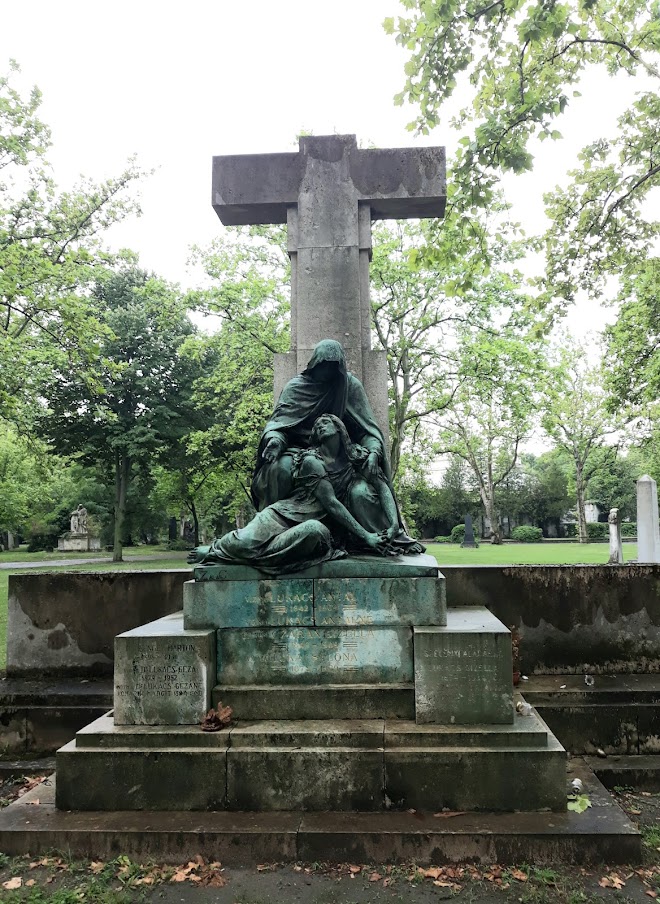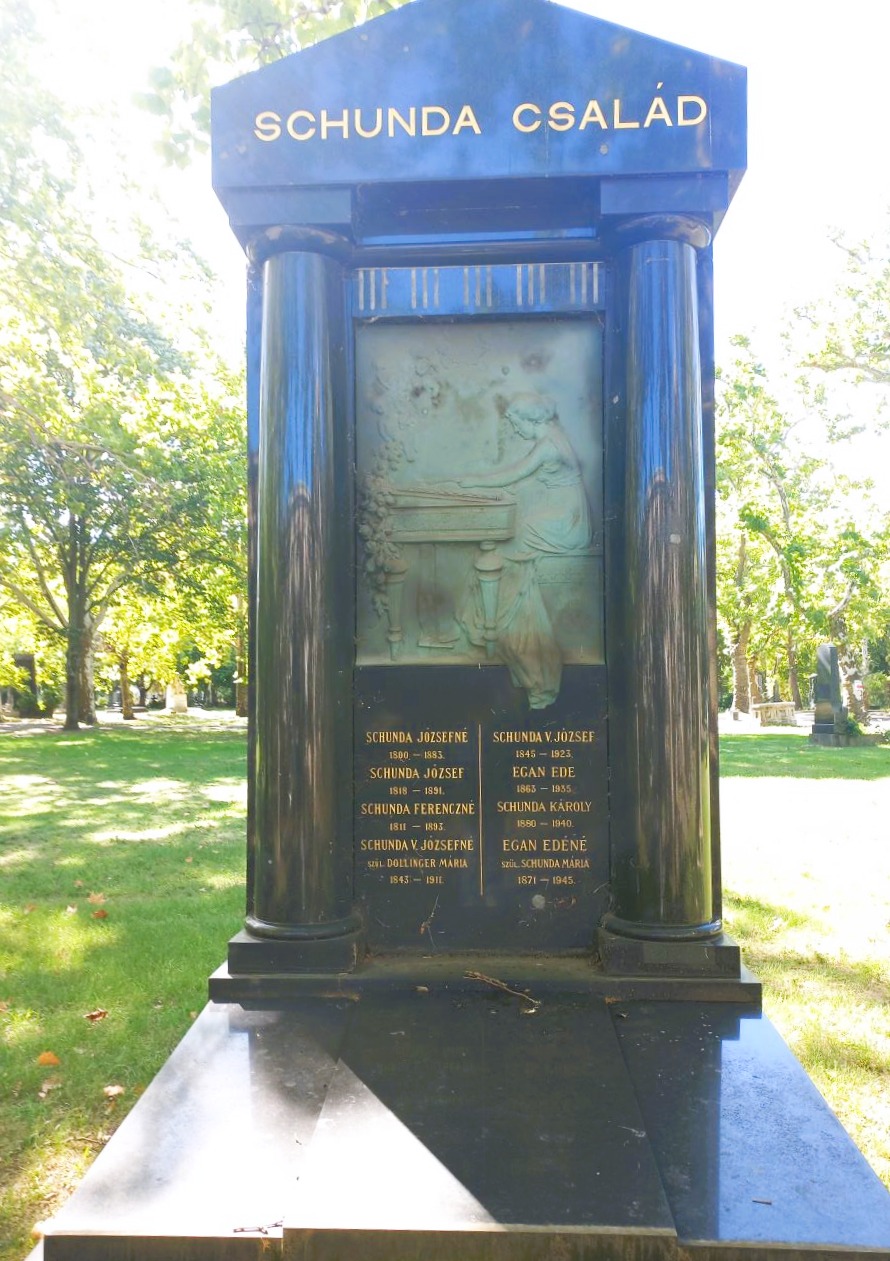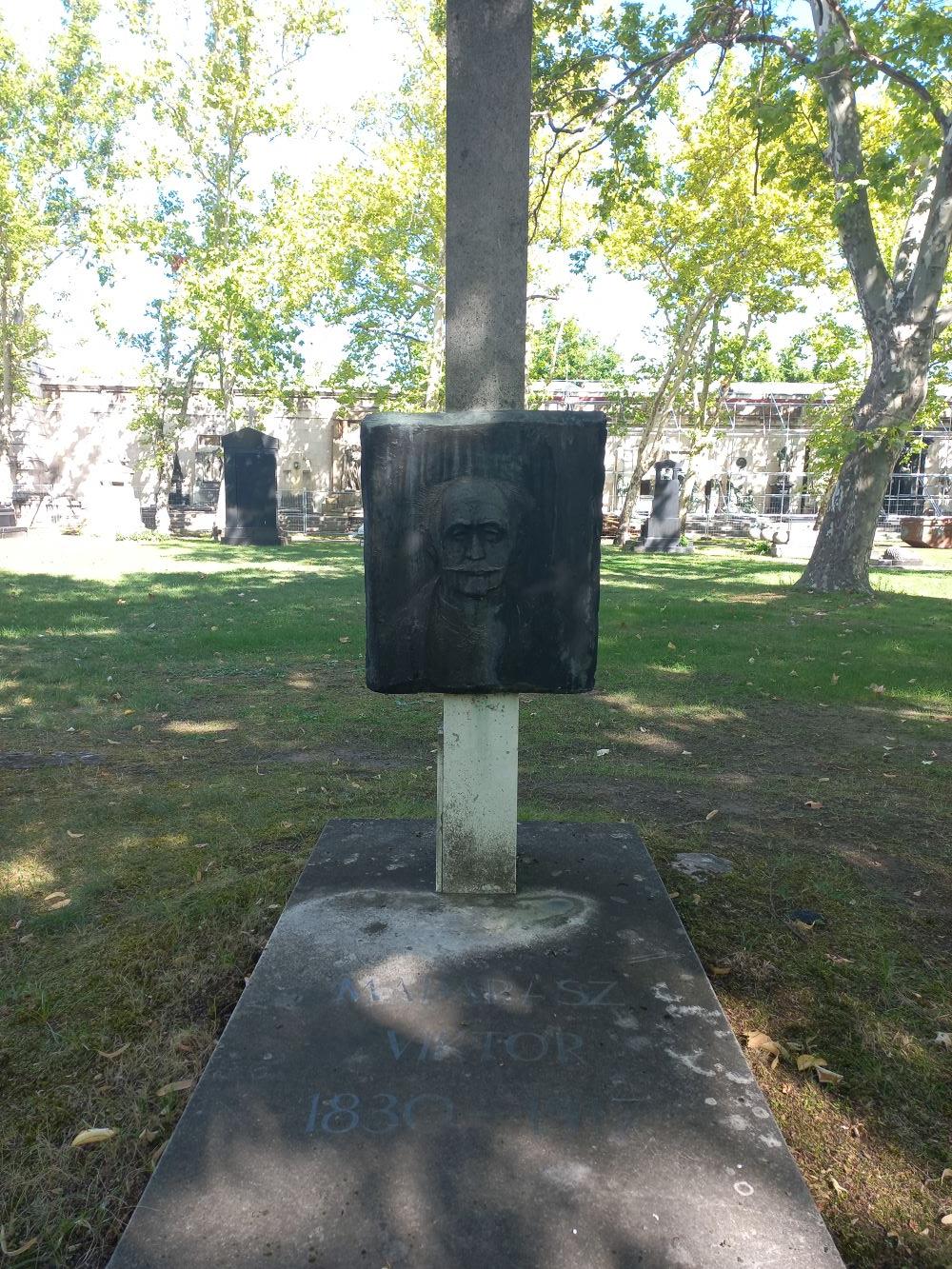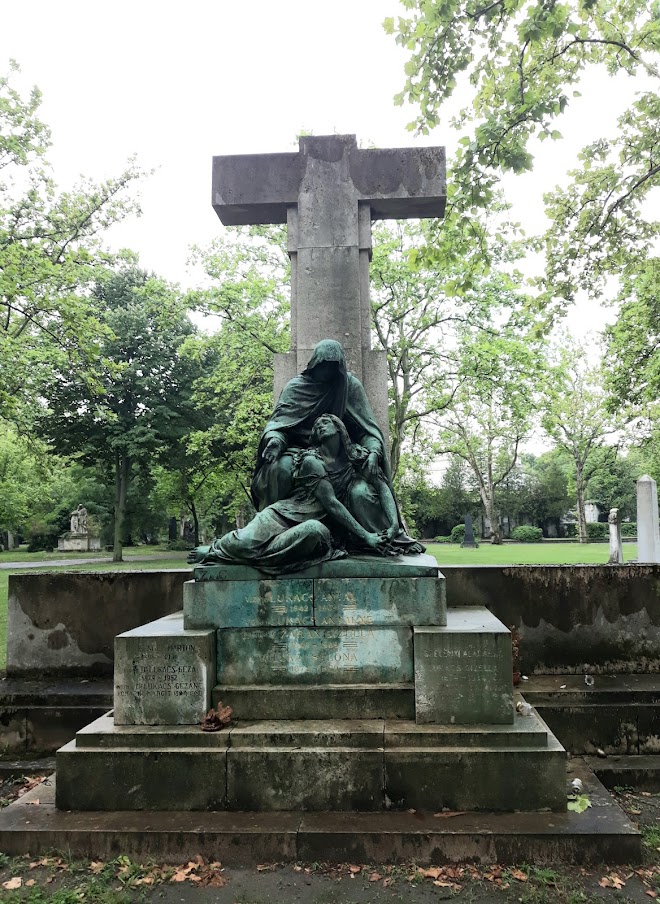
19. parcella
Mária és Magdolna, Lukács Antal síremléke, bronz, 1884 (19-1-1)
Szobrász: Zala György

Az 1884-ben faragott Mária és Magdolna márványcsoport Zala György első klasszikus alkotásának tekinthető, aki ekkor még Münchenben tanulmányi éveit töltötte. Ezzel a szobrával az ifjú művész elnyerte a Képzőművészeti Társulat művészeti nagydíját. A mű komoly sikerét az is jelzi, hogy ennek a korai munkájának köszönhetően országos ismertségre tett szert.
Kétségtelen a kompozíciónak Michelangelo Pietájával való rokonsága, de a két szobor kifejezéstartalma eltér egymástól. A reneszánsz mester művén Mária fia holttestét tartja ölében, Zala kompozíciójában Krisztus alakja helyére Mária Magdolnáé kerül, aki a fájdalmas Szűz elé rogyva kétségbeesetten tördeli a kezét. Az anya fájdalmát átélő, de mégis vigasztalni tudó istenanya tartja a lelket a lábaihoz rogyó, zilált Magdolnában. Ez az ábrázolásmód teljesen új felfogást jelent a hagyományos Pieta-ábrázolásokhoz képest. Az isteni lényegű bűntelen Krisztust Zala György a közfelfogásban bűnös asszonynak titulált Magdolnával cseréli fel, ezáltal válik a legmélyebb fájdalmat átélő, fiát elvesztő Asszony az egész emberiség gondviselőjévé a gyász pillanataiban.
Az eredeti márványalkotást a pécsi Püspöki Palota őrzi.
Schunda Vencel József, bronz, 1912 (19-1-10)
Szobrász: Beck Ö. Fülöp

A neves hangszergyáros 1911-ben elhunyt felesége emlékére készíttette a síremléket az akkor újonnan emeltetett kripta fölé, amelybe a korábban elhunyt családtagjait is áttemettette. A monumentális, klasszicista stílusú fekete gránit emléket a Gerenday Antal és Fia cég készítette, a plasztikai részletét Beck Ö. Fülöp szobrászművész.
A síremlék díszítményeként szolgáló domborművön a „magyar cimbalom”, vagyis egy pedálos cimbalom látható, ami Schunda V. József hangszerész bravúros találmánya volt 1874-ben. A gazdagon díszített hangszeren egy hosszúruhás nő játszik. A füzérben leomló rózsákból éneklő és muzsikáló puttók emelkednek a magasba, akik hegedűn, csellón és tárogatón kísérik a cimbalmozó nő játékát, megidézve az elhunyt, szeretett feleség emlékét.
Madarász Viktor, bronz, márvány, 1967 (19-1-34)
Szobrász: Vigh Tamás

A magyar történeti festészet egyik legjelentősebb alkotójának nyughelye évtizedeken keresztül jeltelen volt, a festőművész síremlékét Madarász Viktor halálának 50. évfordulójára emeltette a főváros. Annak ellenére, hogy a dualizmus korszakának megváltozott politikai hangulatában mellőzött művésszé vált Madarász, a temetésén mégis képviselte magát az akkori művészvilág színe-java. A festőművészt a Szépművészeti Múzeum előcsarnokában ravatalozták fel, amelyet a művész „Hunyadi László siratása“ című képének mintájára rendeztek be. A művész végakarata szerint sírjába rakták azt a kardját is, amellyel 1848-ban, mint honvédhadnagy harcolt a szabadságharcban. A síremlékén a sír kőlapjára állított, magasba nyúló karcsú márványoszlop, mint egy festőállvány helyezkedik el, amin a bronzból mintázott portrédombormű jelenti a vásznat. Az arcképet Vigh Tamás a festőművész 1910-ben festett, szembenéző önarcképe alapján formázta meg, amelyen a hegyes pödrött bajuszú, ritkásodó hajú, mellényt, kabátot és csokornyakkendőt viselő időskorú művész látható.
Mary and Magdalene, tomb of Antal Lukács, bronze, 1884 (19-1-1)
Sculptor: György Zala

The marble Mary and Magdalene composition carved in 1884 can be viewed as György Zala’s first classical piece. At the time he was still studying in Munich. The young artist’s work won him the art grand prix of the Fine Art Society. As an indication of its significance, this early work of his brought him national recognition at a single stroke.
There are indisputable similarities between the composition and Michelangelo’s Pieta, but the expressive content of the two statues differs. In the work by the Renaissance master, Mary cradles the body of her son, whereas in the Zala composition the figure of Christ is replaced with that of Mary Magdalene, who, having collapsed at the feet of the grieving Virgin Mary, wrings her hands in desperation. The Mother of God, experiencing the agony of a mother yet still able to provide succour, supports the distraught Magdalene. This representational mode brings out a completely new dimension compared to traditional Pieta representations. György Zala exchanges the divine essence of a sinless Christ for that of Magdalene, commonly held to be a sinner, and thus the Virgin Mary, losing her son and living through the most profound agony, becomes caregiver of humanity as a whole in the moment of mourning.
The original marble work is preserved in the Bishop’s Palace, Pécs.
György Zala (Alsólendva, 16 April 1858 – Budapest, 31 July 1937)
Of all the sculptors in Hungary at the time, György Zala was perhaps the busiest. He worked exactly at the moment that the country was undergoing major rejuvenation. A member of the great sculptor-troika (György Zala, János Fadrusz, Alajos Stróbl) in the late 19th century, early 20th century, his talent was respected in Greater Hungary and the post-Trianon state as well.
Zala was born in Lendava (Alsólendva) in what is today the territory of Slovakia. He lost his parents when he was still young and his uncles took him in. Since the boy showed no interest in anything other than drawing, they sent him off to Budapest to study. After finishing school he enrolled first at the Technical University and then the School of Modelling. His sculpture Prometheus Chained to the Rock not only won him fame but a scholarship, too, allowing him to continue his studies at the Vienna Academy. Later he studied at the world-famous Munich Academy where he made his first significant statue, Mary and Magdolna, the marble version of which is in the Bishop’s Palace, Pécs and the bronze version in Fiumei Road Cemetery. Zala made numerous public works, among them the memorial to the martyrs of Arad, the National Defence memorial on Dísz Square, the statue of Queen Elizabeth on Döbrentei Square and the original statue of Gyula Andrássy next to parliament, which was later melted down for a statue of Stalin.
György Zala’s most significant and iconic work is the statue composition on Heroes’ Square in the capital. The statue of Archangel Gabriel, which won the Grand Prix at the 1900 Paris World Exhibition, is on top of the column in the centre of the ensemble, and his equestrian statues of the conquering Magyar tribal chieftains and Árpád are in front of the column. Of the 14 statues of royalty erected between the arched columns on what resembles colonnades he made four, the War and Peace composition and all the reliefs.
Vissza a Szoborpark listára